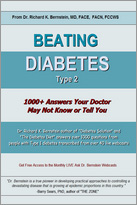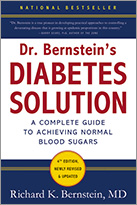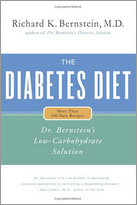HOW TO ESTIMATE YOUR REAL FOOD REQUIREMENTS
Now suppose you have been following our low-carbohydrate diet, have been conscientiously “pumping iron,” and are, in effect, “doing everything right. “What else can you do if you have not lost weight? Well, everyone has some level of caloric intake below which they will lose weight. Unfortunately, the “standard” formulas and tables commonly used by nutritionists set forth caloric guidelines for theoretical individuals of a certain age, height, and sex, but not for real people like
us. The only way to find out how much food you need in order to maintain, gain, or lose weight is by experiment. Here is an experimental plan that your physician may find useful. This method usually works, and without counting calories.
Begin by setting an initial target weight and a reasonable time frame in which to achieve it. Using standard tables of “ideal body weight” is of little value, simply because they give a very wide target range. This is because some people have more muscle and bone mass for a given height than others. The high end of the ideal weight for a given height on the Metropolitan Life Insurance Company’s table is 30 percent greater than the low end for the same height.
Instead, estimate your target weight by looking at your body in the mirror after weighing yourself. (It pays to do this in the presence of your health care provider, because he/she probably has more experience in estimating the weight of your body fat.) If you can grab handfuls of fat at the underside of your upper arms, around your thighs, around your waist, or over your belly, it is pretty clear that your body is set for the next famine. Your estimate at this point need not be terribly precise, because as you lose weight your target weight can be re estimated. Say, for example, that you weigh 200 pounds. You and your physician may agree that a reasonable target would be 150 pounds. By the time you reach 160 pounds, however, you may have lost your visible excess fat—so settle for 160 pounds. Alternatively, if you still have fat around your belly when you get down to 150 pounds, it won’t hurt to shoot for 145 or 140 as your next target, before making another visual evaluation. Gradually you home in on your eventual target, using smaller and smaller steps.
Once your initial target weight has been agreed upon, a time frame for losing the weight should be established. Again, this need not be utterly precise. It’s important, however, not to “crash diet.” This may cause a yo-yo effect by slowing your metabolism and making it difficult to keep off the lost bulk. Bear in mind that if you starve yourself and lose 10 pounds without adequate dietary protein and an accompanying exercise regimen, you may lose 5 pounds of fat and 5 pounds of muscle. If you gain back that 10 pounds from eating carbohydrate and still are not exercising, it may be all fat. After crash dieting, once you’ve reached your target, you may go right back to overeating. I like to have my patients follow a gradual weight-reduction diet that matches as closely as possible what they’ll probably be eating after the target has been reached. In other words, once your weight has leveled off at your target, you stay on the same diet you followed while losing weight—provided, of course, that you don’t continue losing weight. This way you’ve gotten into the habit of eating a certain amount, and you stick to this amount, more or less, for life.
To achieve this, weight loss must be gradual. If you are targeted to lose 25 pounds or less, I suggest a reduction of 1 pound per week. If you’re heavier, you may try for 2 pounds per week. If just cutting the carbohydrate results in a more rapid weight loss, don’t worry—just enjoy your luck. This has happened to a number of my patients. Weigh yourself once weekly—stripped, if possible, on the same scale, and before breakfast. Pick a convenient day, and weigh yourself on the same day each week at the same time of day. It’s counterproductive and not very informative to weigh yourself more often. Small, normal variations in body weight occur from day to day and can be frustrating if you misinterpret them. Generally speaking, you won’t lose or gain a pound of body fat in a day. Continue on your low-carbohydrate diet, with enough protein foods to keep you comfortable.
Let’s say that your goal is to lose 1 pound every week. Weigh yourself after one week. If you’ve lost the weight, don’t change anything. If you haven’t lost the pound, reduce the protein at any one meal by one third. For example, if you’ve been eating 6 ounces of fish or meat at dinner, cut it to 4 ounces. You can pick which meal to cut. Check your weight one week later. If you have lost a pound, don’t change anything. If you haven’t, cut the protein at another meal by one-third. If you haven’t lost the pound in the subsequent week, cut the protein by one third in the one remaining meal. Keep doing this, week by week, until you are losing at the target rate. Never add back any protein that you have cut out, even if you subsequently lose 2 or 3 pounds in a week.*
If you’ve managed to lose at least 1 pound weekly for many weeks but then your weight levels off, this is a good time for your physician to prescribe the special insulin resistance–lowering agents described in Chapter 15. Alternatively you can just start cutting protein again. Continue this until you reach your initial target or until your visual evaluation of excess body fat tells you that further weight loss isn’t necessary. The average non pregnant, sedentary adult with an ideal body weight of 150 pounds requires about 9 ounces of high-quality protein food (i.e., 54 grams of pure protein) daily to prevent protein malnutrition. It is therefore unwise to cut your protein intake much below this level (adjusted for your own ideal body weight). If you exercise strenuously and regularly, you may need much more than this.
Once you’ve reached your target weight, do not add back any food. You will probably have to stay on approximately this diet for many years, but you’ll easily become accustomed to it. If you required one of the appetite-reducing approaches described in the next chapter, do not discontinue it.
*This may not work for girls or women with polycystic ovarian syndrome (PCOS). They may fail to lose weight even on a near-starvation diet (see Appendix E).
SOME FINAL NOTES
Reduce Diabetes Medications While Cutting Protein or Losing Weight
While you’re losing weight, keep checking blood sugars at least 4 times daily, at least 2 days a week. If they consistently drop below your target value for even a few days, advise your physician immediately. It will probably be necessary to reduce the doses of any blood sugar–lowering medications you may be taking. Keeping track of your blood sugar levels as you eat less and lose weight is essential for the prevention of excessively low blood sugars.
Increased Thrombotic Activity During Weight Loss
During weight loss, many people unknowingly experience increased clumping of the small particles in the blood (platelets) that form clots (thrombi). This can increase the risk of heart attack or stroke. Your physician may therefore want you to take an 80 mg chewable aspirin once daily during a meal to reduce this tendency. The aspirin should be chewed midway through a meal to reduce the possibility of irritation to the stomach or intestines. Alternatively you can use vitamin E
in the form of gamma tocopherol or mixed tocopherols. The dosing would be 400 mg one to three times daily depending upon your size. It need not be taken during meals, as it won’t irritate your gastrointestinal tract.
Elevated Serum Triglycerides During Weight Loss
When you’re losing weight, fat is “mobilized” for oxidation—i.e., to be burned—and it will appear in the bloodstream as triglycerides. If you see elevated serum triglyceride levels as you’re losing weight, it’s not something to worry about. Your triglyceride levels will drop as soon as weight loss levels off.
Supplemental Calcium May Help
There is recent evidence that calcium supplements (1,000–3,000 mg daily) may facilitate weight loss by inhibiting the accompanying slowdown in metabolism that may occur when you lose weight. As indicated previously, I recommend calcium supplements that also contain vitamin D, magnesium, and manganese. This supplement has also been used to successfully treat the dysphoric mood and carbohydrate craving in women who suffer from premenstrual syndrome.




